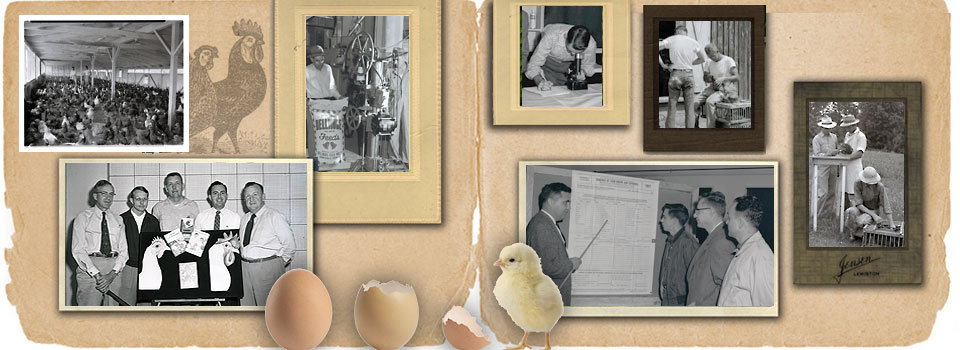It all started with an egg. Well, OK … maybe a few trays of eggs. In the back room of a building at the Georgia College of Agricultural and Mechanical Arts, three turn-of-the-century incubators were busy hatching what is now one of the oldest, most storied poultry science departments in the nation.
“To begin, the old question of which was first in the order of creation-live hen or egg-has been practically settled,” wrote an Athens Banner reporter in a 1912 newspaper notice. “Eggs come first. The state college’s new department began its work with three incubators full of the best eggs to be procured for the purpose of the study and demonstration and research and experimentation.”
The local paper-then the Athens Banner-poked a little fun at the fact that the college, which was not yet a part of the University of Georgia proper, was starting a poultry husbandry program without any live hens. Over the next 100 years, the education and research programs that began at that chickenless poultry department have revolutionized the economy of Georgia and helped to shape the way an entire nation eats dinner.
In only 10 decades, families went from eating chicken less than once a month to eating it several times a week. It’s the nation’s most popular meat; annual per capita consumption of poultry currently exceeds 97 pounds.
“Chicken meat was largely a byproduct of egg production, and now the meat products have become a much larger part of the business,” said Abit Massey, president emeritus of the Georgia Poultry Federation. “It’s one of the greatest success stories in Georgia, and a lot of that success has to do with UGA working with farmers and industry.”
The responsibility of hatching that first set of eggs fell to the university’s first poultry scientist, Leroy Jones. The college’s pioneering new dean, Andrew Soule, hired Jones as a poultry husbandry professor in 1912 in an effort to broaden the college’s course of study. Soule and Jones saw America’s farmyard poultry flocks as an untapped source of economic opportunity for small farmers. Right before Soule hired Jones to teach Farm Poultry Management and Poultry Breeding-the college’s first poultry science class-the U.S. secretary of agriculture released a study placing the value of all the eggs and chickens on American farms at three-quarters of a billion dollars.
What was once the domain of housewives and children-tending chickens and collecting eggs-was on the cusp of becoming big business.
Soule recruited both Jones and Roy F. Irvin, a Michigan College of Agriculture graduate, to head the new department of poultry science, which was formally created in 1914. Shortly after the launch of the department, the college’s trustees funded the construction of the school’s first poultry science buildings.
In the 1920s, ’30s and years following World War II, enrollment in the poultry science program grew steadily as farmers started to see promise in commercial poultry and veterans headed back to school. Poultry science students even had their own dorm, with a sign above the door that read, “Through this portal pass the world’s best poultry men.”
Today, the UGA Department of Poultry Science still produces some of the best poultry men and women in the world.
“Our undergraduates are spread all over the state and all over the world,” said Walter Britton, a retired professor of poultry science.
Mike Lacy, current poultry science department head, likes to remind students who are considering taking classes in the department that “there is one word that describes a poultry science major: employed.”
In 1955, the Georgia Poultry Federation supported the acquisition of funding to construct a poultry research station on Whitehall Road, which was expanded in both the 1970s and 1990s.
In the 1970s, the Georgia Poultry Federation was also instrumental in securing funds to renovate the dilapidated dairy barn-now known as Four Towers-into offices and research facilities for Extension poultry science faculty and staff.
The research done in these new facilities and laboratories, and the development of vertically integrated poultry operations, helped make Georgia the poultry capital of the world. People from around the globe came to see how Georgia farmers and poultry magnates were producing chickens so efficiently.
“The industry was developing so rapidly here,” said Leo Jenson, who retired from UGA in 1990 as a Distinguished D.W. Brooks Professor of Poultry Nutrition. “The university was trying to upgrade and recruit research faculty. We had top people in all fields-genetics, parasitology, nutrition and food science.”
“We’re still leading the world of poultry,” Massey said. “People from other parts of the country and other parts of the world come to Athens to learn more about what we’re doing.”
UGA’s poultry science faculty members are in high demand to share their research at international conferences. In February 2013, more than 100 poultry professionals from all over the world visited the department to hear presentations from the faculty on modern poultry production.
“We are inspired by the accomplishments of the people who built the department’s outstanding reputation,” Lacy said. “The present faculty, staff and students continue that tradition of excellence.”


